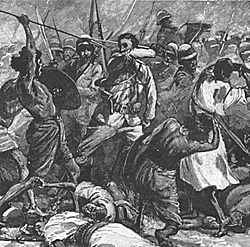 Recently a well-known wargamer raised the question, and answers were attempted in one of these editorials, as to what constituted a Colonial wargame. The answer might seem to be self-apparent in that it is obviously a game fought between disciplined troops and natives, just as a
Napoleonic wargame is one fought between the French on the one hand and some of the Allied
nations on the other.
Recently a well-known wargamer raised the question, and answers were attempted in one of these editorials, as to what constituted a Colonial wargame. The answer might seem to be self-apparent in that it is obviously a game fought between disciplined troops and natives, just as a
Napoleonic wargame is one fought between the French on the one hand and some of the Allied
nations on the other.
But all this rather begs the question because, just as you recognise Manchester United in red and Leeds in white when they play each other, so it is largely uniforms that give the name to a wargame.
I can hear a roar of disapproval and cries of "What about the tactics?" or "How about the formations peculiar to the period?" To these I fully agree that thos and other cogent points are highly relevant and must have a big bearing on the subject but my meaning is rather different.
For example, throughout the 19th century there were British forces in India based on well defended cantonments, from which they occasionally sallied out as expeditions to punish tribesmen, pacify the countryside and even take a little more of it under British control.
Agreed?
Well, how about the situation in Britain in 61 AD when Roman legions were attempting to hold down and pacify the numerous tribes, sent an expedition and carried out a large-scale attack on the Isle of Anglesey, while no doubt battling furiously in the north to hold back the Picts and Scots in an area which must have been just as unpalatable to them as the Khyber Pass was to the British soldier less than a hundred years ago. And, just as Mullahs and Fakirs rose in India to lead hordes of fanatically brave natural warriors against the white soldiers and their trained native allies, so did Boadicea unite the tribes in 61 AD, wipe out an entire legion, destroy Colchester and London until finally brought to bay by a force vastly inferior in size under the capable command of Suetonius Paulinus.
In both cases natives were vastly superior in numbers, incredibly brave and invariably suffered great losses from the skilled disciplined manoeuvres of numerically smaller organised forces, and in both cases took heavy losses from their fire-power. Both the British in India and the Romans in Britain trained and employed native auxiliaries who might well add spice to the wargame by being allocated slightly lower fighting and morale values.
So, what is a Colonial wargame and how differently will the wargamer tackle the two situations described above?
Stuart Asquith's revelation, elsewhere in this journal-that he has gone over from metal to plastic figures struck a familiar and topical note. For years I have advised my impecunious son to divert his attention from attempting to amass huge armies of metal figures that he could not afford and try the very well detailed Airfix and Atlantic plastic figures. The Airfix range by its self-obliterating policy, has made it difficult to build-up armies of their figures, but the Italian-made Atlantic HO/OO scale range happily proliferates. So much so that during a recent visit to France, we spent much time in little toyshops in obscure villages seeking out this range, and successfully finding boxes of a single sprue of 12 figures at 2 francs 50, bigger boxes of three sprues at 6f5O, or large diorama sets at higher prices - all good value today with sterling at its present high rate. Ancient wargamers are advised to seek out the Egyptians, Greeks, Spartans, and Romans - they are good!
Back to Table of Contents -- Wargamer's Newsletter #210
To Wargamer's Newsletter List of Issues
To MagWeb Master Magazine List
© Copyright 1979 by Donald Featherstone.
This article appears in MagWeb (Magazine Web) on the Internet World Wide Web.
Other military history articles and gaming articles are available at http://www.magweb.com